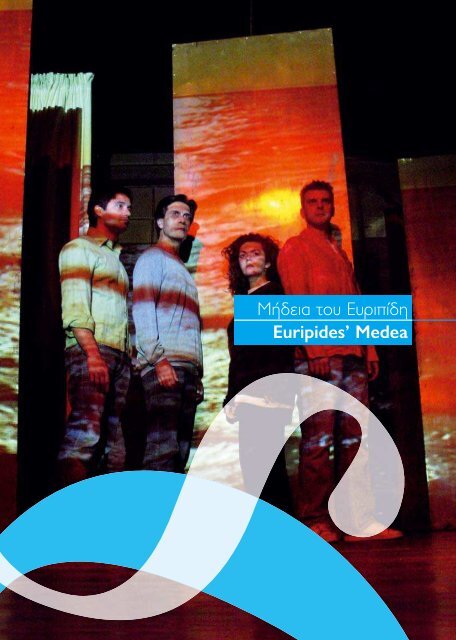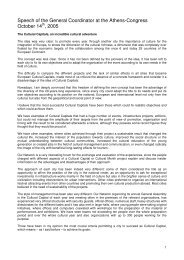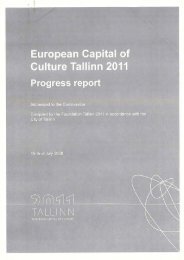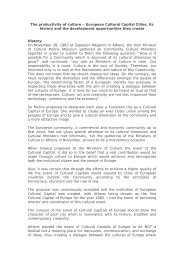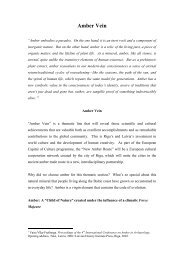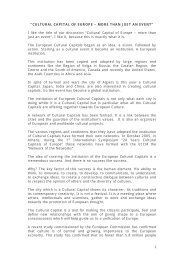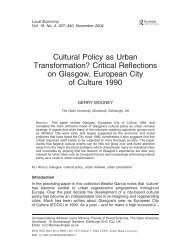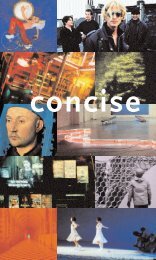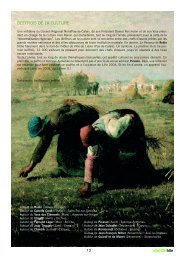patras 2006 - ecoc-doc-athens
patras 2006 - ecoc-doc-athens
patras 2006 - ecoc-doc-athens
Create successful ePaper yourself
Turn your PDF publications into a flip-book with our unique Google optimized e-Paper software.
Μήδεια του Ευριπίδη<br />
Euripides’ Μedea<br />
ΘΕΑΤΡΟ Θέατρο Σηµείο & Τµήµα Θεατρικών Σπουδών<br />
Πανεπιστηµίου Πάτρας: Μήδεια του Ευριπίδη<br />
4, 5 & 7 Ιουνίου <strong>2006</strong> Πτωχοκοµείο<br />
Μετάφραση: Θεόδωρος Κ. Στεφανόπουλος<br />
Σκηνοθεσία: Νίκος ∆ιαµαντής<br />
Σκηνογραφία: Φλώρα Κουτσουµάνη<br />
Μουσική: Στάθης Γραφανάκης<br />
Χορογραφία και Επιµέλεια Κίνησης: Κωνσταντίνος Ρήγος<br />
Ηθοποιοί:<br />
Μήδεια: Ιωάννα Μακρή<br />
Ιάσονας: Γεράσιµος ∆εστούνης<br />
Κρέοντας: Κίµων Ρηγόπουλος<br />
Αιγέας: Αυγουστίνος Ρεµούνδος<br />
Η µεγαλύτερη πρόκληση για ένα σκηνοθέτη είναι η<br />
αναµέτρηση µε ένα από τα σπουδαιότερα δραµατικά κείµενα<br />
που γράφτηκαν ποτέ. Πρόθεσή µας είναι να πλησιάσουµε<br />
βήµα-βήµα, µε σεβασµό και χωρίς φόβο, το πρόσωπο της<br />
γυναίκας που χάραξε ανεξίτηλα τη λέξη εκδίκηση στην<br />
ιστορία του έρωτα. Προφέρουµε το όνοµά της: ΜΗ∆ΕΙΑ.<br />
Αµέσως αναγνωρίζουµε τη γυναίκα, τη βάρβαρη, την ξένη<br />
που εκδικήθηκε µε φρικτό τρόπο τον άντρα που αγάπησε.<br />
Θα τολµήσουµε να εισχωρήσουµε στον κλειστό πυρήνα της<br />
τραγωδίας, εκεί που η άγρια γυναίκα µε την απόλυτη πράξη<br />
της, πράξη που στρέφεται ενάντια στα σπλάχνα της,<br />
αναµετράται µε τον απόλυτο πόνο. Η µορφή της<br />
τοιχογραφίας που σιγά-σιγά εµφανίζεται, η σταδιακή<br />
προσέγγιση των διαφόρων πτυχών που κρύβονται µέσα στο<br />
αρχαίο κείµενο, είναι αποτέλεσµα της αποσπασµατικής και<br />
συστηµατικής ανασύνθεσης. Μέσα από σειρά παράλληλων<br />
δράσεων ενεργοποιούµε τη φαντασία και τη µαγεία της,<br />
ωθώντας τη θεατρική πράξη στα άκρα, συνοµιλώντας<br />
παράλληλα µε τις σύγχρονες τάσεις στο εικαστικό τοπίο.<br />
Η τραγωδία: ένα ζωντανό θέατρο µε συνείδηση.<br />
Νίκος ∆ιαµαντής<br />
Νίκος ∆ιαµαντής<br />
Σπούδασε Θέατρο στη Θεσσαλονίκη στην Ανώτερη Σχολή<br />
«Επιθεώρηση ∆ραµατικής Τέχνης».Το 1985 ίδρυσε στην Αθήνα<br />
το «Θέατρο Σηµείο», το οποίο επιχορηγείται από το Υπουργείο<br />
Πολιτισµού, από το 1985 µέχρι σήµερα. Στο «Θέατρο Σηµείο»<br />
έχει σκηνοθετήσει έργα των S. Beckett, H. Müller, P. Claudel, A. Bioy<br />
Casares, H. Pinter, St. Ign.Vitkievich, Aug. Strindberg,<br />
L. Petrushevskaia, Bernard-Marie Koltès, Christa Wolf. Έχει<br />
επίσης, ανεβάσει Τραχίνιες και Ηλέκτρα του Σοφοκλή καθώς<br />
και σύγχρονα ελληνικά έργα των Βασίλη Ζιώγα, Βάιου Παγκουρέλη,<br />
Γιάννη Χρυσούλη, Στέλιου Λύτρα, Αντώνη και Κων/νου Κούφαλη,<br />
Παύλου Μάτεσι και Κώστα Κατσουλάρη. Ο Νίκος ∆ιαµαντής<br />
διδάσκει υποκριτική και σκηνοθεσία σε σχολές, και σεµινάρια<br />
και σκηνοθεσία στο Πανεπιστήµιο Ναυπλίου.<br />
THEATRE Semio Theatre & Department of Theatrical Studies of the<br />
University of Patras: Euripides’ Μedea<br />
June 4, 5 & 7, <strong>2006</strong> Old Home for the Poor (Ptochokomeio)<br />
36<br />
37<br />
Translation: Theodoros K. Stefanopoulos<br />
Direction: Nikos Diamandis<br />
Scenography: Flora Koutsoumani<br />
Music: Stathis Graphanakis<br />
Choreography and Movement Supervision:<br />
Konstantinos Rigos<br />
Actors:<br />
Medea: Ioanna Makri<br />
Jason: Gerasimos Destounis<br />
Creon: Kimon Rigopoulos<br />
Aegeas: Augoustinos Remoundos<br />
The greatest challenge for a director is confronting one<br />
of the most significant dramatic texts that had ever been<br />
written. Our intention is to successively approach with<br />
respect and not with fear, the character of the woman who<br />
carved the word revenge in the history of love forever.<br />
Her name: MEDEA.At once we recognize the woman,<br />
the stranger who took revenge from the man she loved<br />
in the most hideous way.We will dare to penetrate into<br />
the sealed core of the tragedy, where the savage woman<br />
with her ultimate act of turning against her own children,<br />
confronts utter pain.<br />
The figure of the mural that slowly appears and the gradual<br />
approach to the various hidden aspects of the ancient text<br />
is the result of fragmentary and systematic reformation.<br />
Through a series of simultaneous actions we activate<br />
the imagination and magic by driving the theatrical act to<br />
the limit, while simultaneously tackling modern trends in<br />
the scene.Tragedy is a live theatre with consciousness.<br />
Nikos Diamandis<br />
Nikos Diamandis<br />
He was born in Athens. He studied Theatre in Thessaloniki at<br />
the Advanced School ‘Supervision of Dramatic Arts’. In 1985<br />
he founded the ‘Theatre Semio’ in Athens, which is partially<br />
funded by the Ministry of Culture from 1985 until today.<br />
At the ‘Theatre Semio’ he directed works by S. Beckett, A. Bioy<br />
Casares, P. Claudel, H. Müller, H. Pinter, St. Ign.Vitkievich, Aug.<br />
Strindberg, L. Petrushevskaia, Bernard-Marie Koltès, Christa Wolf.<br />
He has also directed Trachinies and Electra by Sophocles as<br />
well as a lot of contemporary Greek plays by Vas. Ziogas,Vaios<br />
Pangourelis,Yiannis Chryssoulis, Stelios Lytras, Ant. and Konst.<br />
Koufalis, Pavlos Matesis and Kostas Katsoularis.<br />
Nikos Diamandis teaches Acting and Stage Directing at schools,<br />
and seminars and Stage Directing at the University of Nafplion.


